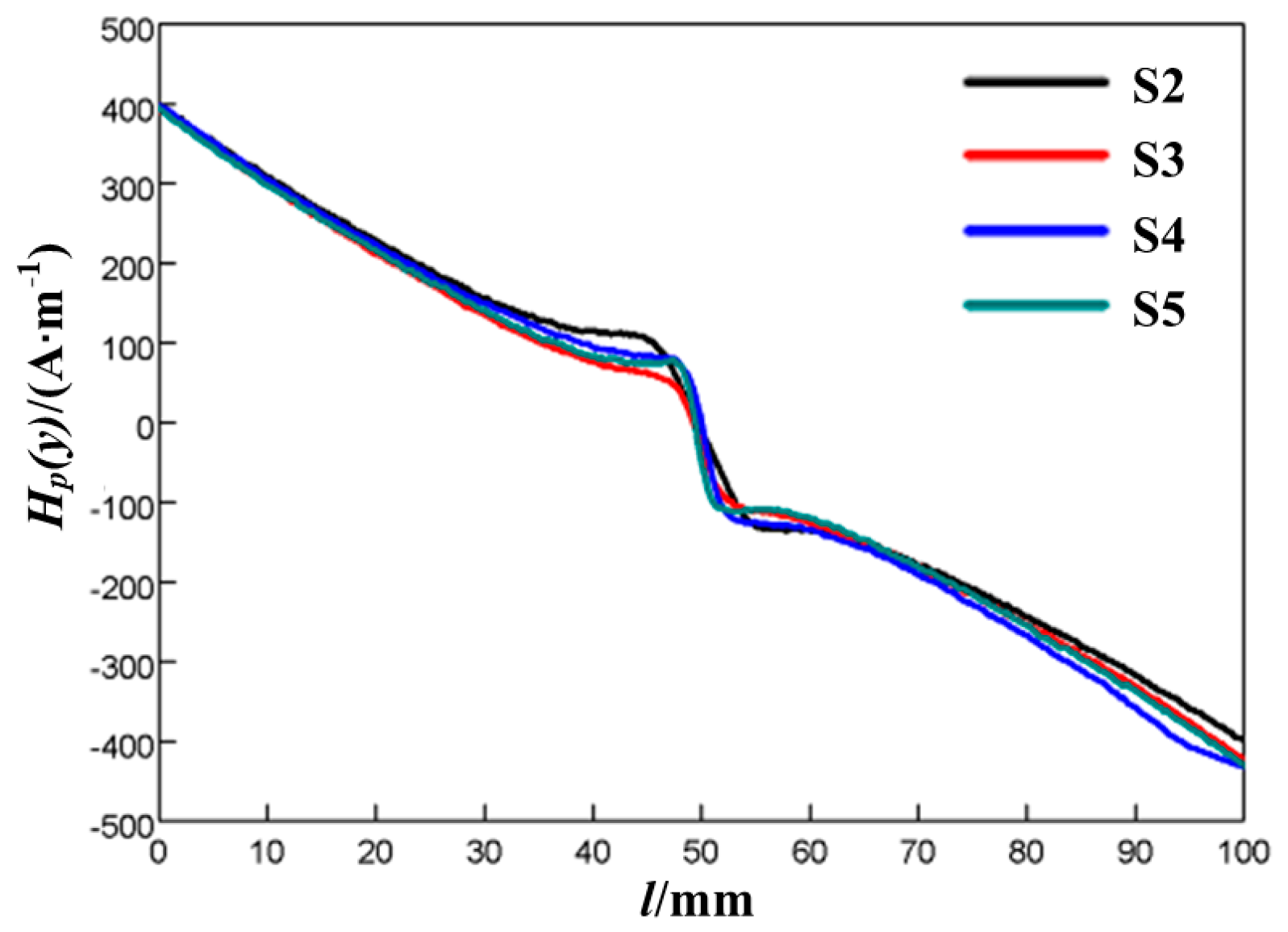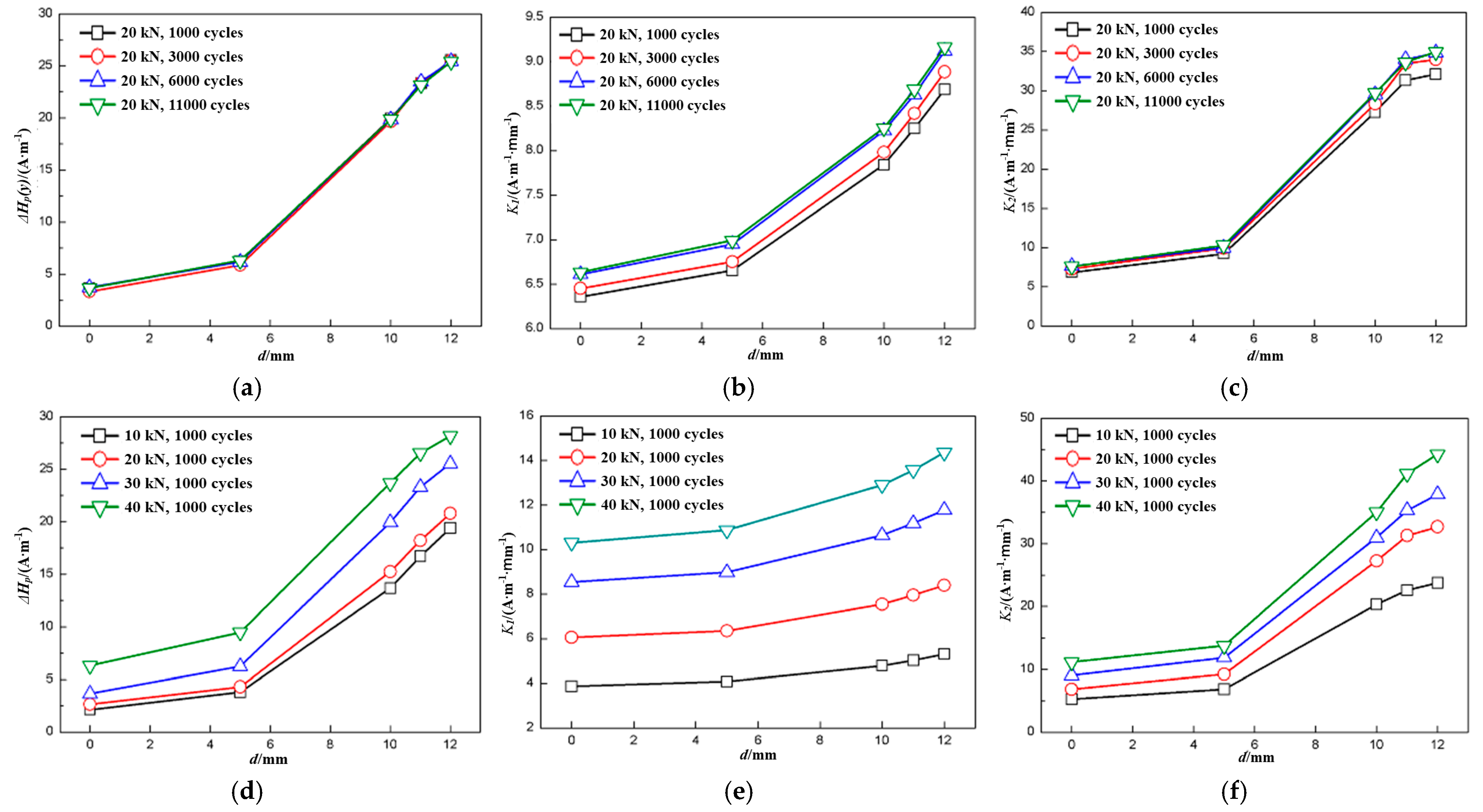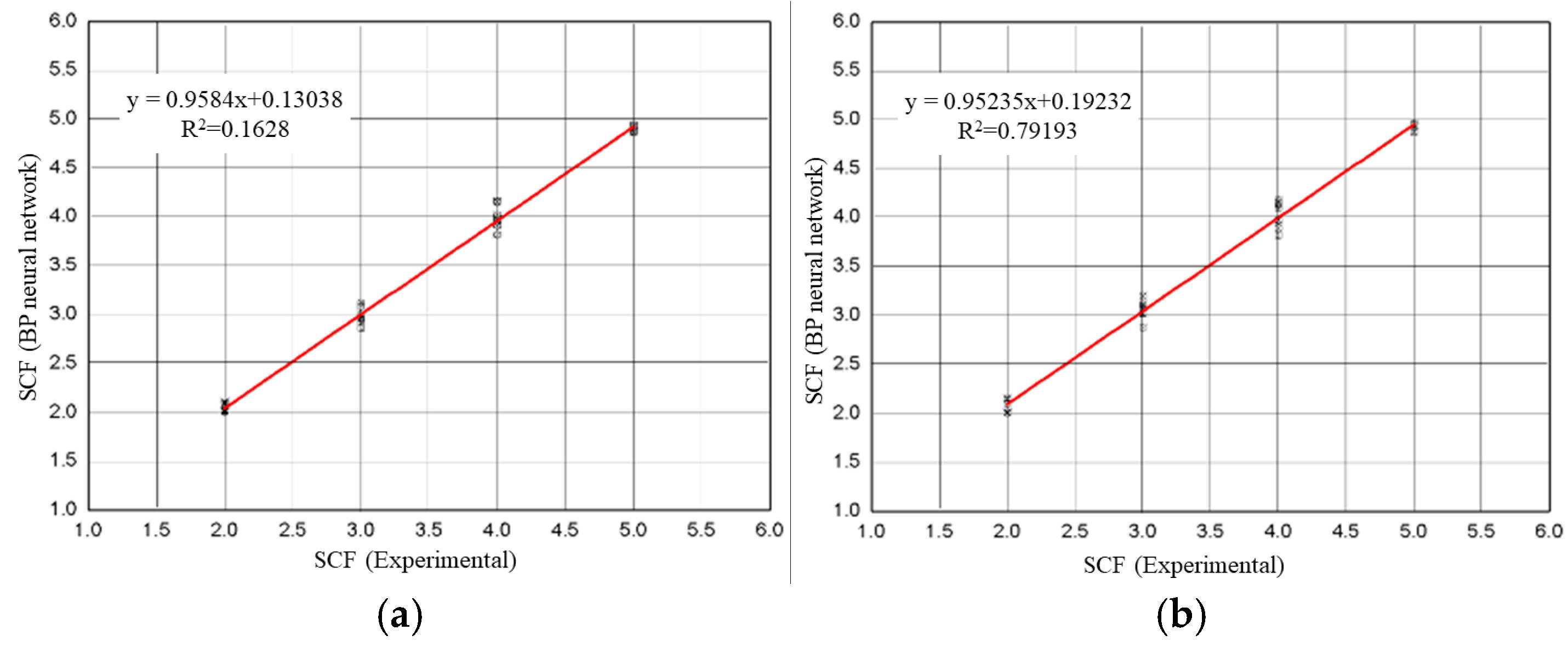Variation in Magnetic Memory Testing Signals and Their Relationship with Stress Concentration Factors During Fatigue Tests Based on Back-Propagation Neural Networks
Abstract
1. Introduction
2. Experimental Methodology
2.1. Specimen Preparation
2.2. Experimental Instruments
2.3. Experimental Arrangement
3. Results and Discussion
3.1. Effects of Fatigue Load and Fatigue Cycle on ΔHp(y), K1, and K2
3.2. Effects of Stress Concentration Degree on ΔHp(y), K1, and K2
4. SCF Recognition by BP Neural Network
4.1. Data Sets for BP Neural Network Development and Pre-Processing
4.2. BP Neural Network Architecture
4.3. SCF Recognition Results
5. Conclusions
- (1)
- ΔHp(y), K1, and K2 were extracted as the characteristics of the MMMT signals. They changed only slightly as the fatigue cycle number increased, but they increased significantly as fatigue load increased, meaning that the MMMT signal could be affected by fatigue load much more easily than the fatigue cycle number.
- (2)
- ΔHp(y), K1, and K2 all increased as the distance between the scan line and the center line increased, and the maximum load during fatigue can easily be distinguished by K1, but none of them could clearly determine the fatigue cycle number.
- (3)
- It is not easy to differentiate SCFs based only on the characteristics mentioned in this article, but a well-established BP neural network could accurately detect the SCFs of specimens.
Author Contributions
Funding
Institutional Review Board Statement
Informed Consent Statement
Data Availability Statement
Conflicts of Interest
References
- Schlitz, W. A history of fatigue. Eng. Fract. Mech. 1996, 54, 263–300. [Google Scholar]
- Hectors, K.; De Waele, W. Cumulative damage and life prediction models for high-cycle fatigue of metals: A review. Metals 2021, 11, 204. [Google Scholar] [CrossRef]
- Kozáková, K.; Klusák, J. Fatigue lifetime predictions of notched specimens based on the critical distance and stress concentration factors. Theor. Appl. Fract. Mech. 2024, 133, 104579. [Google Scholar] [CrossRef]
- Liu, M.; de Oliveira Miranda, A.C.; Antunes, M.A.; Meggiolaro, M.A.; de Castro, J.T.P. Plastic stress concentration effects in fatigue strength. Int. J. Fatigue 2023, 168, 107394. [Google Scholar] [CrossRef]
- Fan, Y.S.; Gao, G.H.; Xu, X.; Liu, R.; Zhang, F.M.; Gui, X.L. A fatigue life prediction approach to surface and interior inclusion induced high cycle and very-high cycle fatigue for bainite/martensite multiphase steel. Int. J. Fatigue 2025, 192, 108723. [Google Scholar] [CrossRef]
- Dubov, A.A. A study of metal properties using the method of magnetic memory. Met. Sci. Heat. Treat. 1997, 39, 401–402. [Google Scholar] [CrossRef]
- Doubov, A.A. Express method of quality control of a spot resistance welding with usage of metal magnetic memory. Weld. World 2002, 46, 317–320. [Google Scholar]
- Shi, P.P.; Su, S.Q.; Chen, Z.M. Overview of researches on the nondestructive testing method of metal magnetic memory: Status and challenges. J. Nondestruct. Eval. 2020, 39, 1–37. [Google Scholar] [CrossRef]
- Chen, N.; Lin, H.; Wang, X.K. Crack propagation analysis and fatigue life prediction for structural alloy steel based on metal magnetic memory testing. J. Magn. Magn. Mater. 2018, 462, 144–152. [Google Scholar]
- Zhou, W.; Fan, J.C.; Ni, J.L.; Liu, S.J. Variation of magnetic memory signals in fatigue crack initiation and propagation behavior. Metals 2019, 9, 89. [Google Scholar] [CrossRef]
- Tong, T.; Zhou, Z.T.; Zhao, R.Q.; Ying, H.J.; Zhang, S.H. Quantitative measurement of stress in steel bars under repetitive tensile load based on force-magnetic coupling effect. Measurement 2022, 202, 111820. [Google Scholar] [CrossRef]
- Sun, S.Q.; Yang, Y.Y.; Wang, W.; Ma, X.P. Crack propagation characterization and statistical evaluation of fatigue life for locally corroded bridge steel based on metal magnetic memory method. J. Magn. Magn. Mater. 2021, 536, 168136. [Google Scholar]
- Zhao, X.R.; Sun, S.Q.; Wang, W.; Zhang, X.H. Metal magnetic memory inspection of Q345B steel beam in four point bending fatigue test. J. Magn. Magn. Mater. 2020, 514, 167155. [Google Scholar] [CrossRef]
- Yang, Y.Y.; Ma, X.P.; Su, S.Q.; Wang, W. Theoretical and experimental analysis of the correlation between magnetic memory signals and cumulative ductile damage of butt weld under low cycle fatigue. J. Magn. Magn. Mater. 2023, 580, 170911. [Google Scholar] [CrossRef]
- Arifin, A.; Abdullah, S.; Ariffin, A.K.; Jamaluddin, N.; Singh, S.S.K. Characterising the stress ratio effect for fatigue crack propagation parameters of SAE 1045 steel based on magnetic flux leakage. Theor. Appl. Fract. Mech. 2022, 121, 103514. [Google Scholar] [CrossRef]
- Zhang, Z.; Friedrich, K. Artificial neural networks applied to polymer composites: A review. Compos. Sci. Technol. 2003, 63, 2029–2044. [Google Scholar] [CrossRef]
- Zhong, W.D. Ferromagnetics (Volume 2); Science Publishing Company: Beijing, China, 1998. (In Chinese) [Google Scholar]
- Atherton, D.L.; Szqunar, J.A. Effect of stress on magnetization and mganetostriction in pipeline steel. IEEE Trans. Mag. 1986, 22, 514–516. [Google Scholar] [CrossRef]







| C | Si | Mn | P | S | Cr | Ni | Mo | V |
|---|---|---|---|---|---|---|---|---|
| 0.42~0.49 | 0.17~0.37 | 0.50~0.80 | ≤0.030 | ≤0.030 | 0.80~1.10 | 1.30~1.80 | 0.20~0.30 | 0.10~0.20 |
| SCF | 2 | 3 | 4 | 5 |
|---|---|---|---|---|
| R | 5.3 | 1.5 | 0.75 | 0.45 |
| 2a | 10.6 | 3 | 1.5 | 0.9 |
| b | 5 | 4.5 | 5 | 5.25 |
| Nodes | 4 | 5 | 6 | 7 | 8 | 9 | 10 | 11 | 12 | 13 |
|---|---|---|---|---|---|---|---|---|---|---|
| SSE | 0.00591 | 0.00534 | 0.00623 | 0.00564 | 0.00465 | 0.00479 | 0.00527 | 0.00555 | 0.00498 | 0.00602 |
| Epochs | 974 | 596 | 632 | 478 | 181 | 186 | 265 | 285 | 380 | 256 |
Disclaimer/Publisher’s Note: The statements, opinions and data contained in all publications are solely those of the individual author(s) and contributor(s) and not of MDPI and/or the editor(s). MDPI and/or the editor(s) disclaim responsibility for any injury to people or property resulting from any ideas, methods, instructions or products referred to in the content. |
© 2025 by the authors. Licensee MDPI, Basel, Switzerland. This article is an open access article distributed under the terms and conditions of the Creative Commons Attribution (CC BY) license (https://creativecommons.org/licenses/by/4.0/).
Share and Cite
Wang, H.; Wang, Q.; Liu, H. Variation in Magnetic Memory Testing Signals and Their Relationship with Stress Concentration Factors During Fatigue Tests Based on Back-Propagation Neural Networks. Materials 2025, 18, 1008. https://doi.org/10.3390/ma18051008
Wang H, Wang Q, Liu H. Variation in Magnetic Memory Testing Signals and Their Relationship with Stress Concentration Factors During Fatigue Tests Based on Back-Propagation Neural Networks. Materials. 2025; 18(5):1008. https://doi.org/10.3390/ma18051008
Chicago/Turabian StyleWang, Huipeng, Qiaogen Wang, and Huizhong Liu. 2025. "Variation in Magnetic Memory Testing Signals and Their Relationship with Stress Concentration Factors During Fatigue Tests Based on Back-Propagation Neural Networks" Materials 18, no. 5: 1008. https://doi.org/10.3390/ma18051008
APA StyleWang, H., Wang, Q., & Liu, H. (2025). Variation in Magnetic Memory Testing Signals and Their Relationship with Stress Concentration Factors During Fatigue Tests Based on Back-Propagation Neural Networks. Materials, 18(5), 1008. https://doi.org/10.3390/ma18051008






